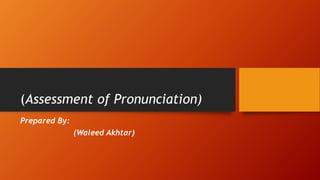
Assessment of pronounciation
- 1. (Assessment of Pronunciation) Prepared By: (Waleed Akhtar)
- 2. Introduction to Assessment • Assessment is a systematic approach to collect information on student learning and performance based on various sources of evidence to inform teaching and help student learn more. • Assessment is an indispensable part of academic settings and the current educational trend favors and environment in which learners are active participants in their own learning in every possible way. • A significant amount of attention has paid to diverse forms of alternative assessment such as portfolio assessment, performance assessment, student’s self-assessment, and so forth.
- 3. What is meant by pronunciation? • Pronunciation is the act or manner of saying a word or an utterance aloud. • It is the result of producing speech sounds: Articulation of sound segments (phones) beside accent and intonation. • Pronunciation refers to the production of sounds that we use to make meaning. It includes attention to particular sounds of language (segments), aspects of speech beyond the level of individual sound such as intonation, stress, phrasing, rhythm, homophones (supra-segmental aspects), how the voice is projected (voice quality).
- 4. What is self-assessment? • Using self-assessment is very useful in academic setting. • It has been argued that self-assessment is an integral part of autonomous learning and that without learner self-assessment, “there can be no real autonomy”. • It can also be added that when self-assessment carries a predisposition toward improvement, there can be real autonomy. • Secondly, self-assessment promotes critical thinking. When teachers allow their students to self-monitor they foster student’s understanding and management of cognitive processes and also help them develop knowledge through conscious control over that knowledge and thought.
- 5. Why we teach pronunciation in ESL? It improves student’s pronunciation and intonation. It helps students to understand the emotions people want to transmit according to their tone of voice. It helps students to become more fluent and to speak more natural. It provides students with new vocabulary. It makes students think in the target language. Students learn about different accents in the target language.
- 6. How many aspects of teaching pronunciation? There are many aspects of teaching pronunciation . The following lesson plan is focused on four aspects that we consider important in teaching or assessing pronunciation: sounds and stress, homophones, tongue twister, and intonation.
- 7. Activity No1. (Sounds, stress and Intonation) Students will be reading two sentences each from the paragraphs until finish it. Recognizing the pronunciation similarity in words.
- 8. Intonation The patterns of rises and falls in pitch is called intonation. Intonation exists in all languages. Concept is neither new nor difficult. Native-speaker-level isn’t the goal. A device to indicate the meaning intended - the emotional meaning. A tool to indicate the feelings of the speaker.
- 9. Example: Say (Good-Bye) oTo a member of your family departing at the airport. oTo someone who has been annoying you. oTo a child starting his very first day at school. oTo a colleague at the end of the training program.
- 10. Another Example: Say (How are you?) To someone who has recently lost a member of the family. To someone who is in hospital. To the head of your institution. To a colleague at the beginning of the day.
- 11. Rhythm • Rhythm is the way that some words are emphasized so as to give the effect of regular beats, (Thorn-Bury, 2006), or fluidity in spoken language. Example 1. If I’d known you were coming, I’d have prepared a meal.
- 12. Stress • Word stress refers to prominence at the word level, while sentence stress refers to the patterns and unstressed syllables over a whole sentence. • Vowel sounds are typically weak and unstressed. • Word stress is a common cause of misunderstanding in English. Example: • Are you going? • Are you going?
- 13. Homophones “The words which sound same but have different structure and meaning called Homophones”. • The teacher will dictate words to you. • Write them down, and then check with a partner. • Did you write the words in the same way? • Some words in English are pronounced exactly the same, but differ in spelling. Example: Son – Sun Blew – blue Need – Knead
- 14. Thank you for paying your attention
